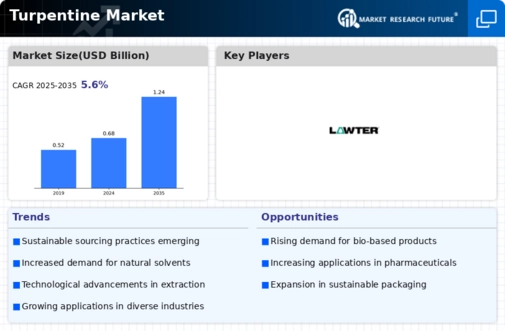Market Analysis
In-depth Analysis of Turpentine Market Industry Landscape
The turpentine market is subject to various dynamics that shape its demand, supply, and overall growth trajectory. Market dynamics in this industry are influenced by factors such as changes in raw material availability, technological advancements, evolving end-user preferences, regulatory policies, and competitive pressures. Turpentine, derived primarily from pine trees, is widely used in various applications such as paints, varnishes, adhesives, fragrances, and solvents, making its market dynamics closely tied to the performance of these industries.
One of the primary drivers of market dynamics in the turpentine industry is the availability and pricing of raw materials, particularly pine resin. Turpentine production heavily relies on the extraction of resin from pine trees, which can be affected by factors such as weather conditions, disease outbreaks, and forestry management practices. Any disruptions in the supply of pine resin can lead to fluctuations in turpentine production, impacting market prices and supply chain stability. Moreover, increasing demand for sustainable and environmentally friendly sourcing practices has prompted companies to explore alternative sources of raw materials, such as plantation-grown pine trees, to mitigate supply risks and meet consumer expectations.
Technological advancements also play a significant role in shaping the dynamics of the turpentine market. Innovations in extraction methods, purification processes, and product formulation have led to improvements in product quality, efficiency, and cost-effectiveness. For example, the development of advanced distillation techniques and solvent recovery systems has enabled manufacturers to enhance the yield and purity of turpentine while reducing energy consumption and waste generation. Additionally, the emergence of biorefinery technologies has opened up new opportunities for the utilization of pine biomass to produce a wide range of value-added products, including bio-based chemicals and renewable fuels, thereby diversifying the revenue streams of industry players and driving market growth.
Furthermore, regulatory policies and standards have a significant impact on the dynamics of the turpentine market. Environmental regulations aimed at reducing emissions, promoting sustainable forestry practices, and ensuring worker safety can influence production processes, product labeling, and market access. Compliance with these regulations is not only essential for maintaining legal and ethical standards but also for safeguarding the reputation and market competitiveness of companies operating in the turpentine industry. Moreover, government initiatives and incentives to promote the use of bio-based materials and support the development of renewable energy sources can create opportunities for market expansion and innovation in the turpentine sector.
Market dynamics in the turpentine industry are also influenced by changing consumer preferences and market trends. Increasing awareness of environmental issues, health concerns, and the shift towards eco-friendly and natural products have led to growing demand for bio-based solvents and renewable chemicals derived from sustainable sources such as pine trees. Manufacturers are responding to these trends by introducing eco-friendly turpentine formulations, promoting sustainable sourcing practices, and emphasizing the environmental benefits of their products to attract environmentally conscious consumers and gain a competitive edge in the market.
Moreover, competitive pressures and market consolidation are shaping the dynamics of the turpentine industry. The market is characterized by the presence of numerous small and large players competing for market share through product differentiation, pricing strategies, and market expansion efforts. Mergers, acquisitions, and strategic partnerships are common in the industry as companies seek to strengthen their market position, enhance their product portfolios, and achieve economies of scale. Additionally, globalization and international trade play a significant role in the turpentine market, with companies expanding their operations across regions to access new markets, resources, and growth opportunities.


 Source: Secondary Research, Primary Research, Market Research Future Database and Analyst Review
Source: Secondary Research, Primary Research, Market Research Future Database and Analyst Review

Leave a Comment